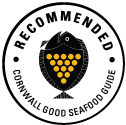

A species of flatfish that is occasionally landed by Cornish trawlers and netters. It is very similar in appearance to a Dover sole but the sand sole is often cheaper and tastes just as good.
This species is not well studied but there is no information to suggest that stocks are being over exploited. The best option is to choose day boat trawled or net caught sand sole.
5 tonnes of sand sole were landed to Cornish ports in 2021 with a value of £17k (MMO data).
Updated July 2023

Cornwall
Demersal trawls are large nets that are pulled through the water with the bottom edge of the net touching the seabed. At each edge the net is pulled open by metal ‘trawl doors’. Sometimes referred to as Otter trawling.
Learn moreCornwall
Gill nets are lightweight nets made of nylon (monofilament) fishing line that are anchored to the seabed and are used to catch fish by entangling the gills.
Learn moreCornwall
Beam trawls are nets attached to a steel beam that holds the net open. The belly of the net is made of chains and the upper surface of the net is mesh. Beam trawlers pull two nets along the seabed simultaneously.
Learn moreCornwall Good Seafood Guide rates fish on sustainability using a scale of 1 to 5.
1, 2 and 3 are recommended, Fish to avoid are rated 5.
We use the system devised by the Marine Conservation Society (MCS) so our scores are comparable with the scores produced by MCS for the UK and fisheries from all around the world. For more information on scoring click here.
Between four and ten tonnes of sand sole are landed to Cornish ports each year (source MMO landings data). This is an under utilised species that has not been well studied in terms of stocks in our area. There is no reason to think that this species is being over exploited at this time.
There is no quota for this species. It is benefiting indirectly from measures to protect other species such as the Trevose closure which protects spawning sand sole and many other species and the effort restrictions brought in during the sole recovery plan. There is no minimum landing size for sand sole.
Sand Sole are caught in gill nets, demersal trawls and beam trawls.






Cornwall Good Seafood Guide is underpinned by the Marine Conservation Society (MCS) Good Fish Guide. The first UK consumer guide to sustainable seafood. For more information visit www.fishonline.org
Cornwall Good Seafood Guide is here to help us all make sustainable seafood choices. Choices that will help us keep the oceans healthy and Cornish fishers' futures safe. This website is funded by Cornwall Wildlife Trust. If you would like to make a meaningful difference to the health of our oceans, please consider making a donation to the Cornwall Wildlife Trust Ocean Emergency fund. Your donation will help safeguard these remarkable environments, ensuring that they continue to thrive for generations to come. Together, we can be stewards of the seas and champions for a healthier, more sustainable future.